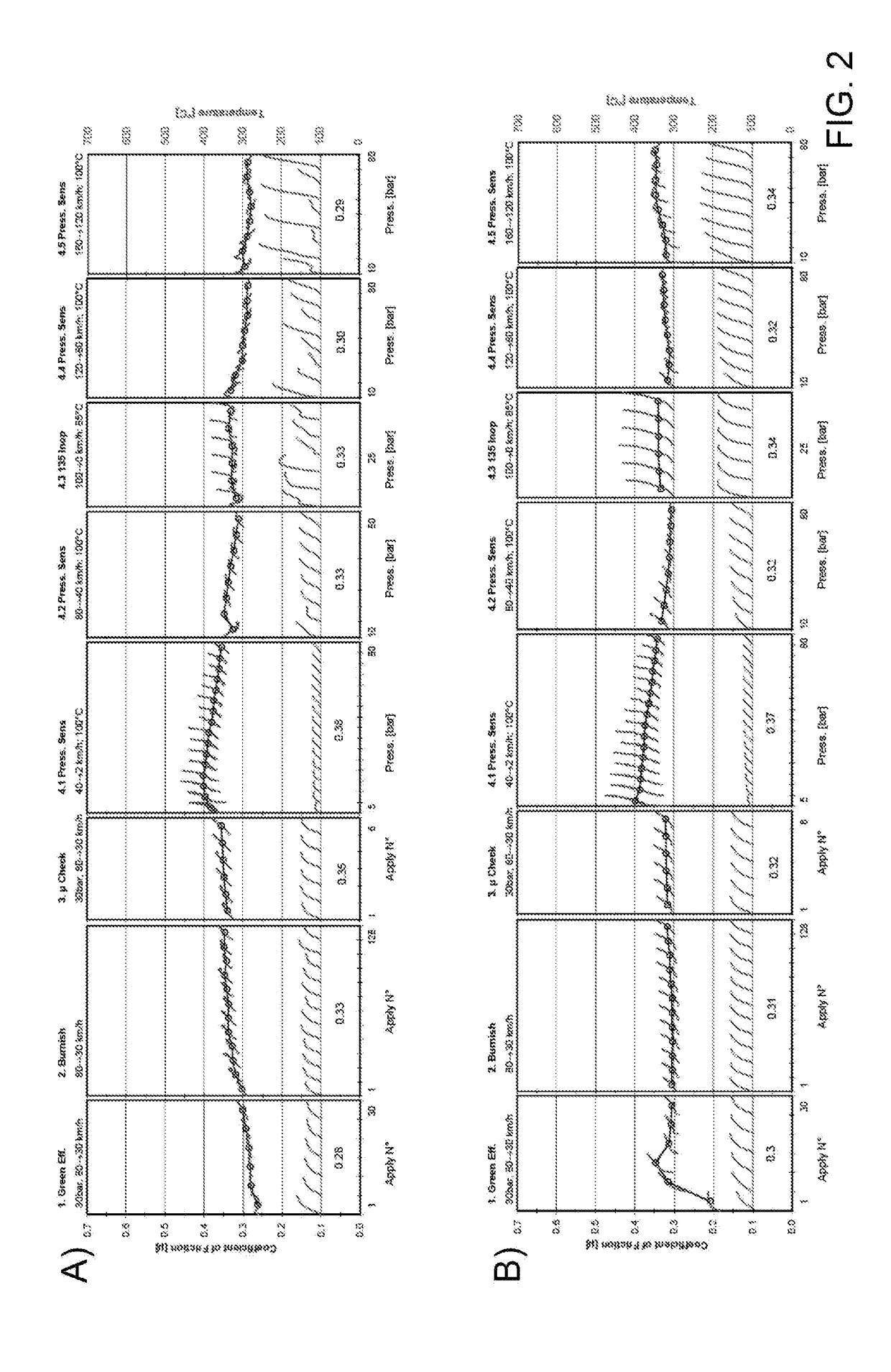Friction material, in particular for the manufacturing of a brake pad, and associated preparation method
a technology of friction material and brake pad, which is applied in the field of friction material, can solve the problems of not being able to be used in vehicles in common use, friction materials that are copper-free involve a decay over time in the coefficient of friction, and well-known toxic effects on human health, and achieve the effect of easy incorporation of graphen
- Summary
- Abstract
- Description
- Claims
- Application Information
AI Technical Summary
Benefits of technology
Problems solved by technology
Method used
Image
Examples
example — 1
Example—1
[0071]Two formulations, which are marked as “Reference 1” and “Compounding” were prepared; the formulation “Reference 1” represents a typical formulation of NAO type friction material which is in common use and obtained in a known manner by mixing all of its components within a Loedige blender; the “Compounding” formulation is substantially identical to that of the reference, except for the replacement of graphite with a lower amount of graphene in a 10 / 2 ratio (i.e. 10 parts of graphite are replaced with 2 parts of graphene), and is obtained by the production process schematically shown in FIG. 1b, to which graphene, instead of being added in a traditional blending step within a Henschel, Loedige or Eirich type blender, is added to the organic binder in the fluid state within the blender 9 of FIG. 4.
[0072]The compositions of the two formulations described above are shown in table 1 below.
TABLE 1Reference 1Compounding% Vol% VolAramid fiber66Friction powder1415Resin2122Mediu...
example — 2
Example—2
[0077]Three formulations were prepared, which are marked as “Reference 2”, “Graphite / Graphene (1:1)” and “Graphite / Graphene (10:2)” according to the quantities given in Table 2.
TABLE 2Reference Graphite / Graphite / 2Graphene (1:1)Graphene (10:2)Aramid fiber444Resin202020Graphite500Graphene051Mild abrasive101011Strong abrasive9910Medium abrasive101011Sulfides444Coke202021Metallic fibers141414Metallic powders444Total100100100
[0078]The “Reference 2” formulation represents a typical formulation of NAO type friction material which is in common use and similar to the “Reference 1” formulation of example 1. The “Graphite / Graphene (1:1)” formulation is substantially identical to the “Reference 2” formulation except for the fact that the graphite content was fully replaced with an equal amount of graphene. The “Graphite / Graphene (10:2)” formulation is substantially identical to that of the reference except for the replacement of graphite with a lower amount of graphene at a ratio of 10...
example — 3
Example—3
[0085]From the efficiency tests according the AKM standard of example 1, the wear data reported in Table 3 are extrapolated, which relate to braking tests on cast iron brake discs.
TABLE 3FORMULAReference 1CompoundPad Wear [gr]6.24.3Disc Wear [gr]13.37.8
[0086]Comparing the wear of the brake pads and of the relative disc (“braking partner” in the technical language) it can be noted that the replacement of graphite with graphene leads to less pad wear even with a reduced amount of graphene (replacement of 10:2) in the case of the “Compounding” mixture, where the reduced amount of graphene is added using the preferred method of the invention by means of the roller mixer 9 of FIG. 5. The disc wear is also reduced.
PUM
 Login to View More
Login to View More Abstract
Description
Claims
Application Information
 Login to View More
Login to View More - R&D
- Intellectual Property
- Life Sciences
- Materials
- Tech Scout
- Unparalleled Data Quality
- Higher Quality Content
- 60% Fewer Hallucinations
Browse by: Latest US Patents, China's latest patents, Technical Efficacy Thesaurus, Application Domain, Technology Topic, Popular Technical Reports.
© 2025 PatSnap. All rights reserved.Legal|Privacy policy|Modern Slavery Act Transparency Statement|Sitemap|About US| Contact US: help@patsnap.com



